Join The Great British inDepth Biomonitoring Network
Isn't it time you had better data for your marine projects?
We are building a unified marine biodiversity monitoring data platform for waters of the British Isles. We are now inviting expressions of interest from collaborators and marine data users.
Key features:
- Unified marine biodiversity data from around the British Isles
- Time-series monitoring for understanding seasonal phenology and annualised trends
- Publicly available data analytics to contextualise biodiversity with environmental variables
- Collaborative approach for meeting the monitoring challenges of multiple stakeholders.
Key benefits:
- Monthly marine biodiversity time-series data analytics platform
- Powered by a network of sample collection nodes located around the British Isles
- Monitoring for marine fishes, marine mammals, non-native species, water quality
- Using standardised multiparameter observations including temperature, salinity, dissolved oxygen with bioacoustics and eDNA
Share Your Needs: register your interest to help us tailor our approach and meet your specific monitoring challenges.
Currently, there is a significant gap in understanding the composition, health, and population status of inshore fish communities, as well as the scale and impact of critical pressures on these communities. Furthermore, the UK lacks a regular monitoring plan for marine and aquatic non-native species. We need to develop a deeper understanding of the dynamics of marine biodiversity if we hope to improve the effectiveness of management and conservation efforts.
To address these issues, we propose a collaboration with fisheries conservation authorities, marine and maritime industries, academics, conservation organisations and other stakeholders around Great Britain. Our goal is to establish a unified, publicly accessible multi-year time-series database of coastal marine biodiversity built from standardised monthly sample collections by 2025.

Currently the world's longest, Applied Genomics has successfully completed analysis of a 12-year eDNA-based fish biodiversity time-series in collaboration with Plymouth Marine Laboratory, demonstrating the efficacy and return-on-investment of DNA-based methods for biodiversity monitoring. The eDNA results predicted a decline in fish community diversity up to 3 years ahead of scientific trawl surveys which were conducted in the same area.
Strategic planning for biodiversity conservation requires comprehensive data on species distributions and population trends. Conventional catch-and-count survey methods are labour-intensive, invasive, and often fail to capture the entire fish community. Leveraging innovative eDNA sampling technologies, along with bioacoustics and multi-parameter sensing, provides a more complete and efficient and scalable solution to marine biodiversity monitoring, supplementing conventional methods. This approach provides broader species coverage and cross-validation, addressing the gaps in current monitoring strategies and delivering open, interoperable marine biodiversity data to multiple stakeholders.
We are seeking expressions of interest from collaborators and data end-users to build a UK-wide marine biodiversity monitoring network. This network will combine eDNA sampling with bioacoustics and environmental sensors to provide comprehensive and up-to-date information on marine inshore fish communities. Our risk-based analysis ensures the credibility of species detection from eDNA and bioacoustics data, incorporating targeted use of conventional methods where necessary.
The Great British inDepth Biomonitoring Plan has been fully costed to deliver outstanding return on investment, providing high-value data, enabling data-driven decision-making and adaptive management. This initiative will uncover new trends in marine organism distributions, support biosecurity surveillance, and offer significant return on investment. Additionally, it will serve as a global demonstrator for the effectiveness of this biodiversity monitoring strategy.

We invite collaborations from fisheries, maritime, offshore energy sectors, academics and other marine stakeholders. Locations of data nodes will be agreed with collaborators.

